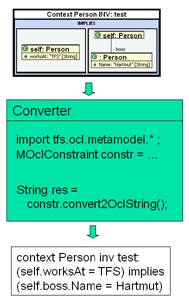| section: < previous | next > | | | |
chapter: << previous | next >> |
Foundations and principle functioning
 The converter is implemented as a separate plug-in, only depending on the meta-model the editor uses to represent instances of Visual OCL diagrams. For this the converter’s capabilities can be extended or changed independently from the editor’s as long as the meta-model does not change substantially. The following gives an idea of how all the converters of this project operate in principle which is depicted also in the lateral sketch:
The converter is implemented as a separate plug-in, only depending on the meta-model the editor uses to represent instances of Visual OCL diagrams. For this the converter’s capabilities can be extended or changed independently from the editor’s as long as the meta-model does not change substantially. The following gives an idea of how all the converters of this project operate in principle which is depicted also in the lateral sketch:
First, the user draws a meta-model instance of a Visual OCL diagram with the editor, which passes it to the converter by calling a single static method. This separation emphasizes the plug-in character of the converter. The converter will transform the instance of the visual diagram in an instance of a given OCL meta-model if possible.
Implementing an OCL meta-model as a Java package was the main topic of the Visual Language Project in summer 2002. The converter uses this package for building instances that represent OCL constraints in its well-known textual form. Every class of this package owns a method called “convert2OclString()”. Finally the converter only has to call this method for the root object of the built constraint structure in order to get the constraint in textual form.
| section: < previous | next > | | | |
chapter: << previous | next >> |
